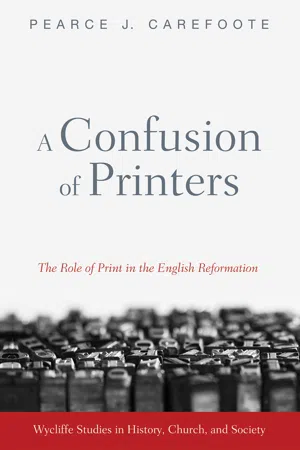![]()
7
Catholic Printers
under Elizabeth
Those authors and printers who remained loyal to the old church were caught in a strange vise that emerged during the Elizabethan period. On the one hand, especially at the beginning of the reign, there was a growing desire for religious tolerance, expressed by the queen herself, who professed to have no desire to see into men’s souls. On the other hand, especially after her excommunication by Pope Pius V (1504–1572) in 1570, the attempted assaults on the queen’s person by Catholics like Sir Anthony Babington, and the Spanish invasion threat of 1588, there was a greater clamor for the control of seditious and heretical writings. The odd result was that Catholics were free to believe but not to worship and that printers who, by their books and pamphlets, assisted and brought comfort to Catholics could be arrested and tried for sedition rather than heresy.
Catholic printers were forced to go into hiding once again. It is known that three clandestine Catholic presses operated in London between the years 1578 and 1582, for example, in the years before the Spanish Armada. William Carter (d. 1584) ran a press on Tower Hill, Richard Rowland (d. 1640) operated another in Smithfield, and Stephen Brinkley (fl. 1585) manned the third, in East Ham. Each of the presses was eventually discovered and dismantled. Carter, who had apprenticed under the Queen’s Printer John Cawood during the reign of Queen Mary, was executed for printing Father Gregory Martin’s A Treatise of Schism, which had been deemed treasonous. Rowland, however, fled to the Continent, where he produced polemical works under the name of Richard Verstegan. His most famous and influential was his Theatrum crudelitatum haereticorum temporis nostrae, published at Antwerp in 1588, the year of the Armada.
Title page to Verstegan’s visual polemic against the persecution of Catholics by Protestants, printed at Antwerp in the Armada year, 1588.
Unlike some other Catholic publications of the period, this book was not intended to inspire the faithful to martyrdom so much as rouse in them a sense of indignant horror at Protestant atrocities. The book was designed in four distinct parts by Verstegan so that they could be sold separately if so desired. The first part deals with the persecution of Catholics under Henry VIII; the second, the persecution by the Huguenots during the first civil war in France in 1562; the third, the persecution by Calvinist soldiers under William of Orange against Flemish Catholics; and the last, the abuse of Irish and English Catholics under Elizabeth I. By far, the most violent illustrations appear in parts two and three, and while the images are self-explanatory, each also has a six-line hexameter verse composed by Johannes Bochius, town secretary of Antwerp, reflecting on the sorrowful scene displayed. For example, beneath the only known contemporaneous image of the execution of Margaret Clitherow, the York martyr, he writes, “Female sex, your reputation commends you also. The stout heroine was not dejected even in the midst of extreme torture. The weights and millstones did not disquiet your tender body. No, she said, ‘Place mountains upon my limbs. My innocent spirit shall pass through the ruins of my body and reach the stars.’” Each engraving includes a legend with letters corresponding to a description on the facing page that editorializes as well as explains the scene.
The martyrdom of Margaret Clitherow of York from Verstegan’s Theatrum.
Verstegan purposely called his work a “theatre,” since, as he explained, “the eye is held by pictures, and what is brought before the eyes has greater effect than that which is brought to the ears.” The intentionally repugnant character of the illustrations combined with their poetic reflections to serve as a “thinly disguised political and military manifesto for Philip II,” who governed Flanders at this time. Verstegan established himself at Antwerp in 1587, only two years after the city had been reclaimed from the Calvinists by Spanish Catholic forces. In that same year he published the first edition of this book, shortly after the execution of Mary, Queen of Scots, whom he declared the legitimate heir to the English crown. Not surprisingly, the tableau of her death features last in the Theatrum. The work, which saw eight editions in twenty-two years and inspired contemporaneous Continental Catholic propagandists such as Michael ab Isselt (d. 1597) and Lawrence Beyerlinck (1578–1627), has been described by some scholars as an Armada pamphlet. By means of it Verstegan was helping to provide Catholic Europe with a justification for the invasion of England in response to the sufferings of the English Catholics depicted herein. The unsuccessful invasion was, of course, attempted in the year that this edition appeared.
Among the Catholic printers, the case of Stephen Brinkley is in many ways the most interesting. His press was a typically small operation, set up in the private home of Francis Browne, the brother of the Viscount Montague, in East Ham, where he hoped to avoid the suspicions of local authorities. The Jesuit Father Robert Persons (1546–1610), one of the priests who worked for the reconversion of England during Elizabeth’s reign, recorded that seven men continually worked Brinkley’s East Ham press day and night, issuing pamphlets and small books to counter the steady stream of propaganda being published by the licensed Protestant press. Persons was arguably the most adept at harnessing the power of the illegal Catholic press. A Somerset recusant, he had returned to England in 1580 as one of the first Jesuit missionaries committed to the reconversion of the island. While his confrère Edmund Campion (1540–1581) attempted to arouse enthusiasm for the old religion through his homiletical skills, Persons worked at sowing the seeds of political discontent through his publications. At East Ham, Brinkley published at least six books bearing a false Louvain imprint before one of his servants was arrested and racked until he revealed the location of the press, which was subsequently...


